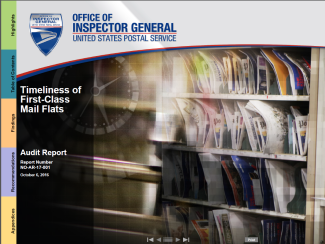Timeliness of First-Class Mail Flats
Background
In fiscal year (FY) 2015, the U.S. Postal Service delivered about 154.2 billion pieces of mail and packages, 62.4 billion of which were First-Class Mail (FCM). During the same fiscal year in Quarters (Q) 2 through 4, the Postal Service processed about 1.2 billion FCM® flats, generating $1.7 billion in revenue. FCM flats include newsletters, magazines, and large envelopes weighing up to 13 ounces.
In FY 2016, Qs 1 and 2, the Postal Service delivered 77.8 billion pieces of mail and packages, 32.9 billion of which were FCM.
During the same period, the Postal Service processed about 825.2 million FCM flats, generating $1.2 billion in revenue. The Postal Service considers FCM to be delayed when it is not processed in time to meet its established delivery day.
Postal Service customers have continued to express concerns about the timeliness of FCM flats processing. Our objective was to assess the timeliness of FCM flats processing.
What The OIG Found
As noted in prior U.S. Postal Service Office of Inspector General (OIG) reports, the Operating Window Change in Q2, FY 2015, significantly impacted mail processing and resulted in large increases in delayed mail. However, the Postal Service has taken steps to address these delays and, as of Q3, FY 2016, 3-5 day and 2-day FCM flats service scores were within 1 percentage point of Q3, FY 2014, service scores.
Although FCM flats service scores have significantly improved, they are still below Postal Service target goals. Nationwide, 3-5 day FCM flats service performance for Q3, FY 2016, was 75.2 percent — 20.05 percent below its goal — and 83 percent for its 2-day FCM flats service performance — 13.5 percent below its goal.
To address specific stakeholder concerns about delayed FCM flats mail, we conducted observations at nine judgmentally selected Processing and Distribution Centers (P&DC) in FL, GA, MO, NY, OH, and WA. We found processing challenges that impacted the timeliness of FCM flats processing, including:
- Lack of timeliness in moving mail at seven of the P&DCs due to a lack of communication between dock and processing personnel.
- Rehandled mail at six of the P&DCs due to inconsistent standard operating procedures.
- Limited availability of mail transport equipment at four of the P&DCs due to a lack of monitoring, tracking, and oversight of mail transport equipment.
- Late arriving mail received from other facilities at all nine P&DCs.
- Unapproved or outdated operating plans at seven of the P&DCs.
- Disproportionate staff to mail volume ratio at seven of the P&DCs due to outdated run plan generator models.
When mail is delayed, it increases the risk of customers losing confidence in the Postal Service’s ability to provide trusted and reliable service. This could directly harm the Postal Service’s brand, lead customers to seek alternative delivery options or use digital alternatives, and ultimately reduce revenue.
What The OIG Recommended
We recommended management improve communication between dock and processing personnel; follow standard operating procedures for rehandled mail; and improve monitoring, tracking, and oversight of mail transport equipment. We also made recommendations in another report concerning the tracking and processing of late arriving mail and updating and approving operating plans and have initiated a separate audit focused on use of the run plan generator. Therefore, we are not making recommendations in this report about these three issues.

